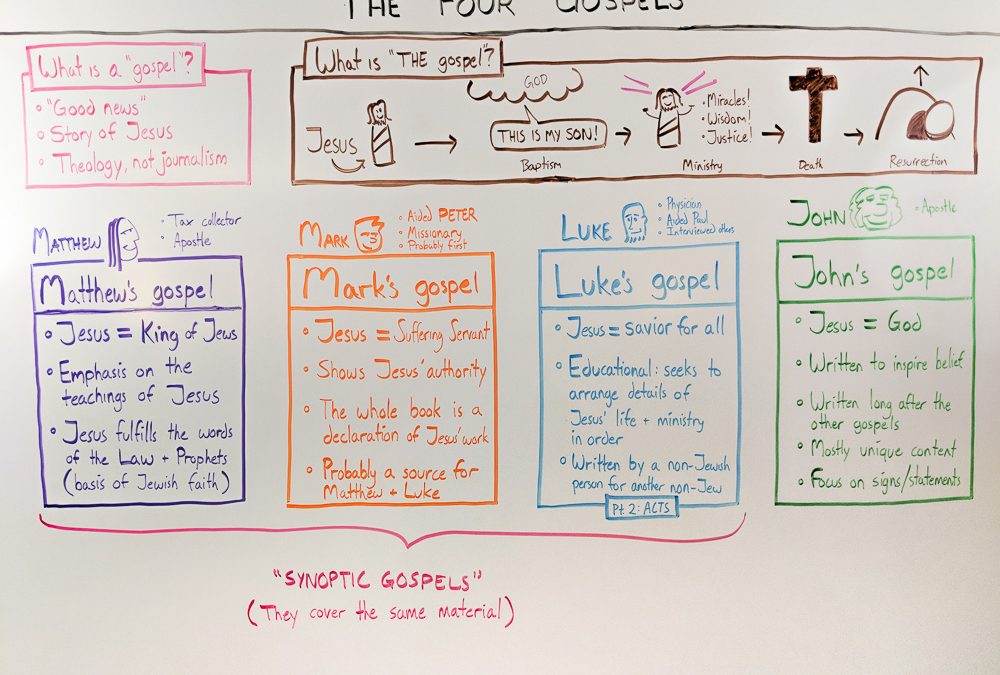

The first four books of the New Testament are known as the Gospels: Matthew, Mark, Luke, and John. Each book tells us about the life, ministry, death, and resurrection of Jesus Christ.
Let’s get a high-level overview of these four books, what makes them different, and how they’re similar.
The Gospels are where we find all the famous Bible stories about Jesus. Because each Gospel is about the same main character, they all share several elements.
For example, each of the four gospels follows this general progression:

Many people (including myself!) have asked, “Do we really need four gospels in the Bible? That seems redundant. Shouldn’t one do the trick?”
Maybe that would be the case if Jesus were a regular person who just did regular things. But he isn’t, and he didn’t.
John says that the world itself couldn’t hold all the books that could be written about Jesus’ ministry (Jn 21:25). He’s probably being hyperbolic, but if there’s that much to say about Jesus, then we shouldn’t be surprised that we have multiple accounts of him in our Bible. If the world couldn’t hold his whole story, then surely a 16-chapter pamphlet like Mark couldn’t!
We have four gospels because during the early church period, four people found it necessary to tell the story of Jesus from four different perspectives. Each gospel was written for a different (original) group of people, by a different author, who was trying to accomplish a different purpose.
Let’s take a closer look at each one:
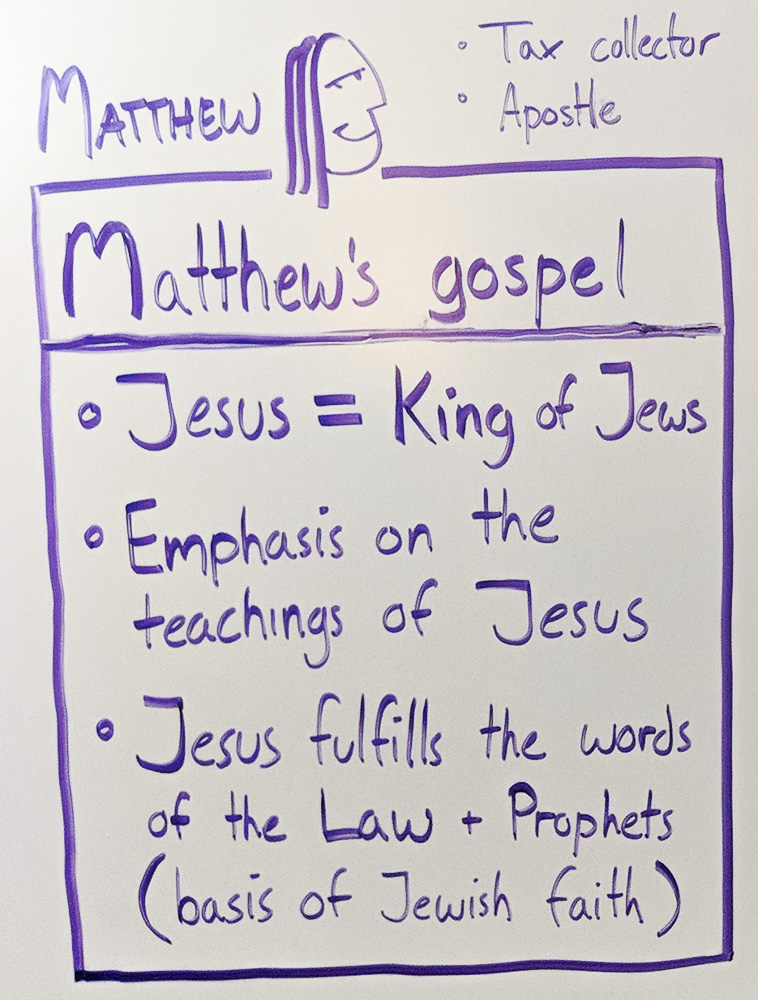
Traditionally penned by the apostle of the same name, Matthew is the first gospel of the four. This gospel was written for people familiar with the Old Testament, both the Law of Moses and the prophets. Matthew makes more references to the Old Testament than any other gospel.
Matthew takes great care to show how Jesus fulfills the prophecies made about him earlier in the Bible—especially focusing on Jesus’ role as the Messiah. (The promised king descended from David.)
Today, Matthew is the perfect book to bridge the gap between the Old Testament and the New. In the famous Sermon on the Mount, Jesus says, “Do not think that I have come to abolish the Law or the Prophets; I have not come to abolish them but to fulfill them” (Mt 5:17).
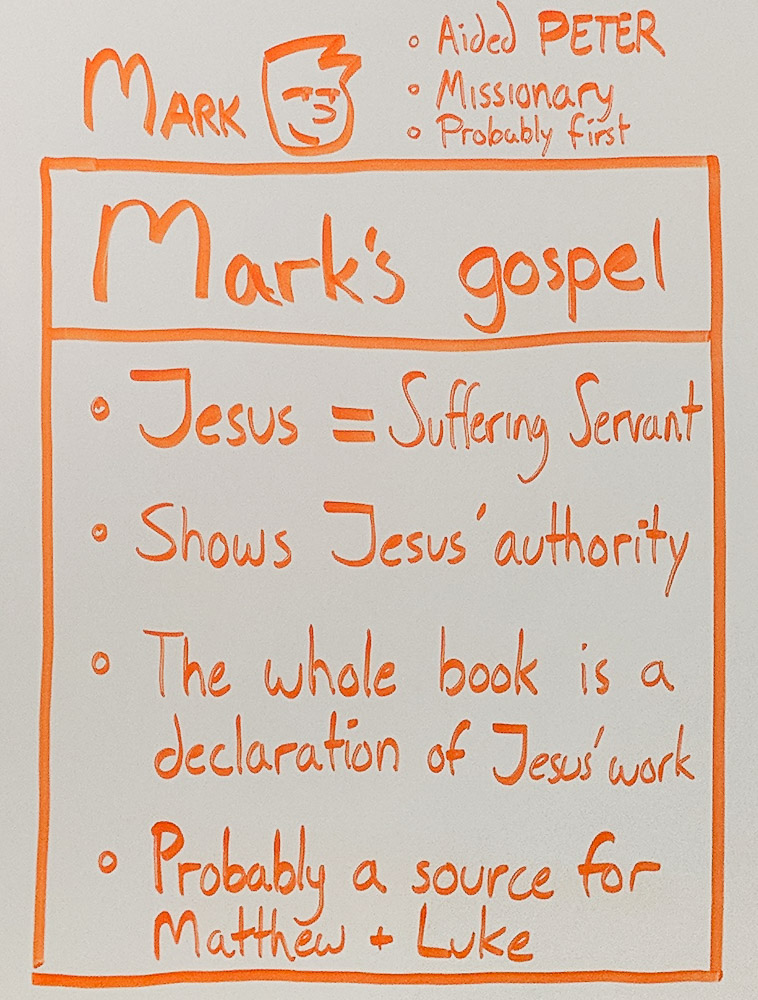 The Gospel of Mark
The Gospel of MarkThis is the shortest gospel. In fact, it’s possible that this gospel was written so that it could be easily memorized and told aloud—written to “go viral,” if you will.
According to early church tradition, this gospel was written by John Mark, the same guy who backed out of his missionary journey with Paul and Barnabas (Ac 15:37–39). Mark purportedly aided the apostle Peter later in life, and this gospel is an arranged collection of Peter’s memories of Jesus.
Mark was written for a wide audience. This gospel focuses on Jesus’ role as the suffering servant and son of God. While the other gospels contain long discourses and sermons of Jesus, Mark is all about action. This is where we see Jesus doing things, and then doing more things. It’s very action-oriented (the word “immediately” shows up frequently), and of the four gospels, Mark reads most like a story.
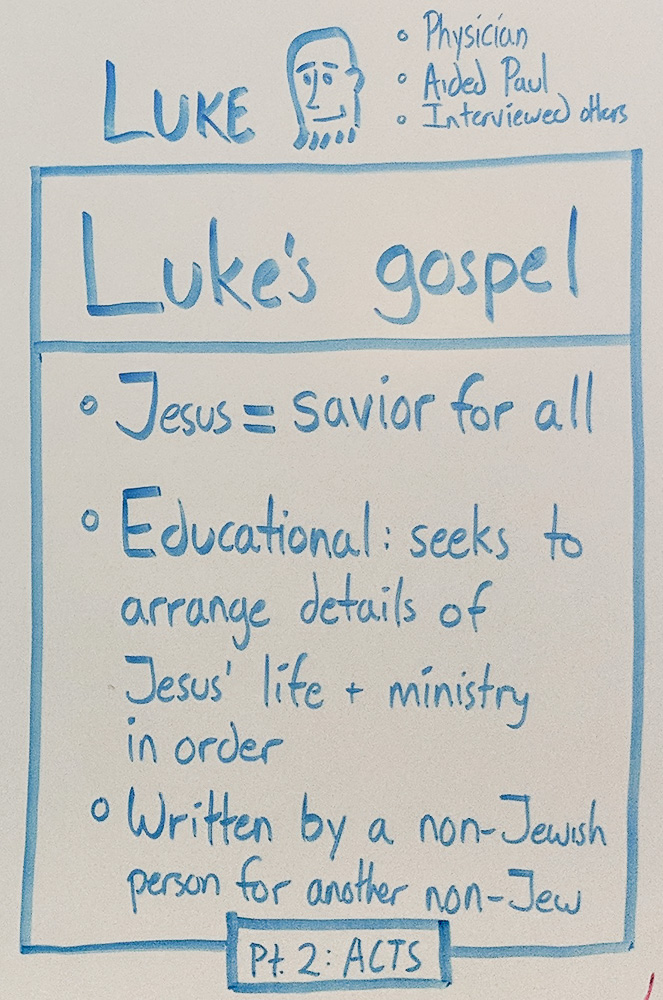
This is the longest of the four gospels—in fact, it’s the longest book of the New Testament for that matter. Luke is the historical, journalistic Gospel: a thorough account of the episodes in Jesus’ life arranged in chronological order. This gospel was written to establish believers in the teachings of Jesus (Lk 1:1–4).
Church tradition recognizes the first-century physician Luke as the author and editor of this book, which is how it gets its name. Luke may be one of the only non-Hebrew authors of the Bible based on a few clues we pick up in the New Testament. This gospel presents Jesus as the seeking savior of all nations (Lk 2:30–32). It was and continues to be a rich story of Jesus’ life and ministry for both those who don’t know much about Jesus and those who have a great deal of familiarity with the Old Testament.
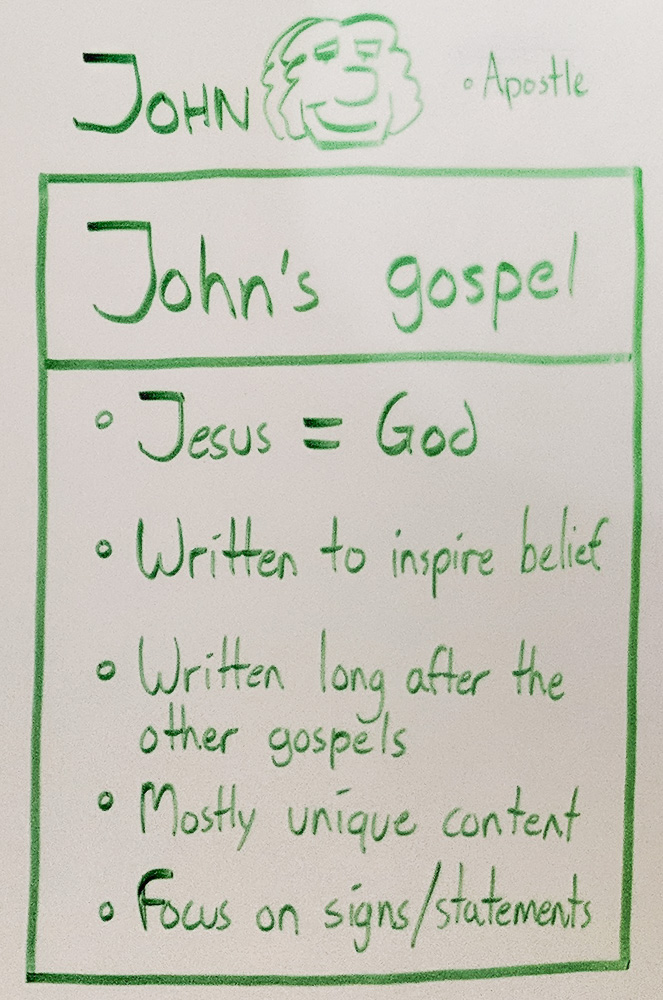 The Gospel of John
The Gospel of JohnJohn is the persuasive Gospel. It’s written to show the miracles of Jesus, so that those who read his story will believe in him and have everlasting life (Jn 20:30–31).
John’s account of Jesus’ teachings and miracles emphasize the divine nature of Jesus Christ. To John, Jesus is the cosmic Son of God, come to destroy the works of the devil. The whole book is arranged to present Jesus this way.
That means the gospel of John has a very different feel from the other three. The way the gospel starts is a good example. Mark begins with Jesus’ baptism. Luke begins with the happenings surrounding Jesus’ birth. Matthew begins with Abraham, and traces the generations down to Jesus. But John takes us all the way back to the very first words of the Bible: “In the beginning” (Jn 1:1). John is telling the story of the divine being who became flesh, dwelt among us, and died so that we might have everlasting life.
Do you wish you knew the Bible better?I wrote The Beginner’s Guide to the Bible to give people a non-preachy, jargon-free overview of what the Bible is, what it’s for, and what it’s all about. You’ll walk away from it with enough knowledge to have a thoughtful conversation about the Bible with a pastor, an atheist, or anyone else.
The gospels, like the other books of the Bible, were intended to be read in one sitting. That doesn’t mean every time you read from John you need to read the whole thing. But it does mean that if you want to know one of them better, you should set aside an hour or so to read the whole gospel in one go.
This gives you a feel for the general “flow” of the gospel’s narrative. You’ll notice different recurring motifs. You’ll see how the tone shifts in different movements.
As you read the gospels, ask these questions:
Why are there so many different gospel accounts? I’ll write a whole post on why this is the case soon, but in the meantime you may want to check out Dr. Mark Strauss’s video course on how these four different perspectives describe Jesus. (Heads-up: if you buy it, Zondervan gives me a small kickback.)
Having just read all four of your gospel overviews with diagrams, I must say they are wonderfully clear and simple— what an invaluable teaching & ministry resource! I also admire the way you stressed that people should read each gospel right through at one sitting if possible, to understand the whole story, instead of just dipping into the Bible here & there, like some kind of recipe book. While many Christians are happy to read an entire romantic novel or thriller in a couple of days, they are encouraged to jump back & forth between single verses in the Old & New Testaments, analysing a few verses each day, completely out of their original context, and therefore lose the intended meaning. The New Testament is the very foundation of our faith, and yet how many Christians have ever taken time to read it patiently through from beginning to end? Well done to you for trying to “make their paths straight”.
Betty Smith on December 31, 2019 at 3:40 pmHi Jeffery,
I would like to purchase a DVD of your teaching on Leviticus and maybe get a printout of your board. How can I go about getting a DVd and a printout and what is the price?
Thanks for the vote of confidence, Betty! I don’t have a DVD option right now, but I am hoping to provide some video services later this year. Stay tuned … ;-)
Cassidy on May 1, 2019 at 1:17 pmCould I format what’s on that whiteboard into a infographic? Is there special permission I need to do so? Thanks!
Jeffrey Kranz on May 1, 2019 at 2:03 pmYou’re free to use it in a noncommercial way, Cassidy! All I ask is that you link back to this page to let folks know where you got the content and structure. Hope it’s helpful!